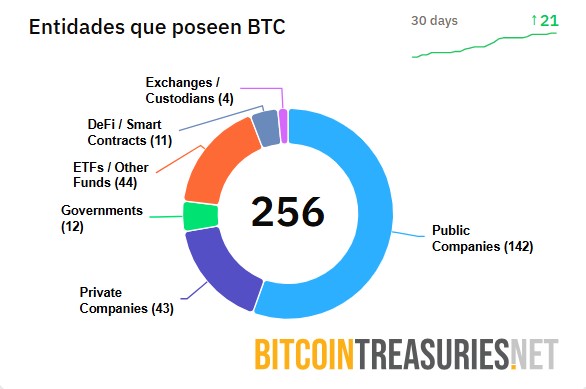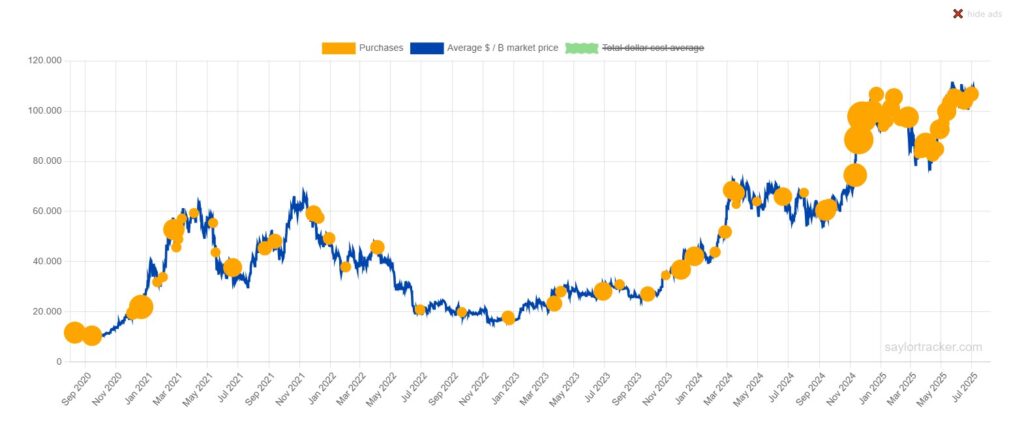Nothing is finance is infallible, Breed recalls.
Only the largest companies could survive a Bitcoin bearish market.
The adoption of Bitcoin (BTC) by companies has not been a passing trend. On the contrary, the digital currency has acquired prominence in an increasing way, not only for its valuation so far this year, but for its incursion into corporate balances.
However, there is a possible systemic risk About BTC, according to the Breed financial analysis and research firm. And this is due to The proliferation of companies that replicate the Strategy modelthe Bitcoiner company Michael Saylor, which takes debt for purchase more bitcoin.
Since last year, a wave of companies announced new treasury strategies dedicated to Bitcoin. From those who simply added BTC to their balances, even others that followed Strategy’s steps And they focused their business exclusively on the possession of BTC, as is the case of the Japanese Metaplanet.
In general, about 185 entities, between quoted and not quoted in the stock market, collectively have more than 1.14 million BTC, representing approximately 123,000 million dollars, as can be seen below:

Strategy, by itself, has accumulated 597,325 bitcoin. It is the stock exchange company with more custody coins. His treasure is equivalent to 53% of corporate participation in BTC.
Another 141 stock exchange companies have joined the adoption of BTC and, together, control 4.05% of the total currency supply, which is 21 million units. That is, about 852,000 BTC.
In the following graph, the stock exchange companies that accumulate Bitcoin are seen:

Other companies, between contributed and not quoted in the stock market, which have more than 10,000 BTC include block, by Jack DORSEY, with 164,000 Bitcoin, Tether (100,500 BTC), Mara Holdings (50,000 BTC), Twenty One (37.230 BTC), Riot Platforms (19,200 BTC), Galaxy Digital Digital) (12,800 BTC), Cleanspark (12,500 BTC), Tesla (11,500 BTC) and Hut 8 (10,300 BTC).
For Breed, although the corporate tendency to adopt Bitcoin has proliferated as a strategic reserve and treasury asset, “it is almost guaranteed that Strategy will continue to be BTC’s main holding company.”
The Strategy model
The Strategy model that has been followed by dozens of companies is distinguished by maintaining a majority position in BTC and finance this acquisition through the use of debt.
In essence, the company of Michael Saylor has used strategies such as the issuance of convertible debt, sale of market shares and reinvestment of its operating cash flow in sustained purchases of BTC, as reported by cryptonotics.
The next graphic It shows the purchases of Bitcoin that Strategy has made since 2020.

The concept behind this model is that companies not only buy BTC as an investment, but are valued depending on the currency performance. To attract investors and justify the valuation of their shares, Companies must generate a profitability superior to that of BTC itself.
This cousin, known as MNAV (multiple of the net value of assets), has been a key indicator of the viability of the strategy. For example, Strategy’s MNAV is currently 1.7x, reflecting the company’s capacity to manage your assets effectively and create additional valuethey point out from Breed.
The risk of replicating Strategy
However, the growing number of companies that mimic Strategy’s model could have serious implications for the Bitcoin market, Breed analysts say.
They argue that, although the largest companies have the necessary scale and support to face a bearish market, Those that just adopt the strategy face a much greater risk.
According to the investigation firm, the risk of market correction is considerable, since companies that depend excessively on debt to finance the purchase of BTC could face great difficulties.
They consider that, if the price of BTC fell significantly, these companies They would be forced to sell their holdings to cover their debt obligationswhich could generate a spiral of price drop and forced sales, affecting market stability.
In addition, they think that, in a prolonged recession, companies that do not have the same reputation and resources that Strategy could be forced to liquidate part of their assets to fulfill their maturities. This, according to Breed, It could amplify the downward pressure throughout the cryptocurrency market.
The alert on a bearish scenario for Strategy was made in June by Matthew Sigel, head of Vaneck digital asset research. He said that replicating this model has its risks because if some companies collect capital through large programs in the market to buy BTC, The value could be diluted instead of increasing itbringing negative consequences for shareholders, as reported cryptootics.
Meanwhile, financial analyst Jacob King compared Strategy’s model with a Ponzi scheme. According to King, the company’s finances enter a cycle that It will only continue to work if the BTC price continues to rise. If one of the steps of this cycle fails, the model could collapse.

Is there departure?
The specialists of the Galaxy Digital analysis firm have warned of this scenario. For them, there is a clear risk in financing the purchase of debt assets, especially through convertible zero coupon bonds.
Given this scenario, they consider that Treasury companies have several options to avoid more problems in case of a great BTC price drop. An option would be to sell your BTC reservations to get the necessary money and face your obligations, which could generate a bearish pressure in the price of the asset, even affecting other companies with BTC in their balances.
Another option would be to refinance its debt, a common strategy in the financial world, although it depends on market conditions. However, adverse conditions They could increase the cost of indebtedness and future financial risk.
They could also issue new actions to raise funds, which would dilute the participation of current shareholders. And the most extreme option would be to enter default if the value of its reserves does not cover the debt, which could generate a loss of trust and legal actions of creditors.
The risks are already raised
While the Strategy model has proven to be successful so far, the growing adoption of Bitcoin by companies through similar strategies raises risks that could trigger a crisis in case of significant market correction.
Specialists agree that, although large companies can count on resources to support volatility, smaller companies that mimic this indebted model can face serious consequences if they fail to properly manage their risks.
As they see it from Breed, although there is a moderate risk of infection, of giving a mass liquidation it is possible and probable that Strategy and other great players intervene with financial help to paralyze the domino effect and consolidate the industry.
Only time will say whether this model is really sustainable in the long term, or if, on the contrary, it will end up being a lesson of dangers to borrow massively to buy Bitcoin (or any other asset).


